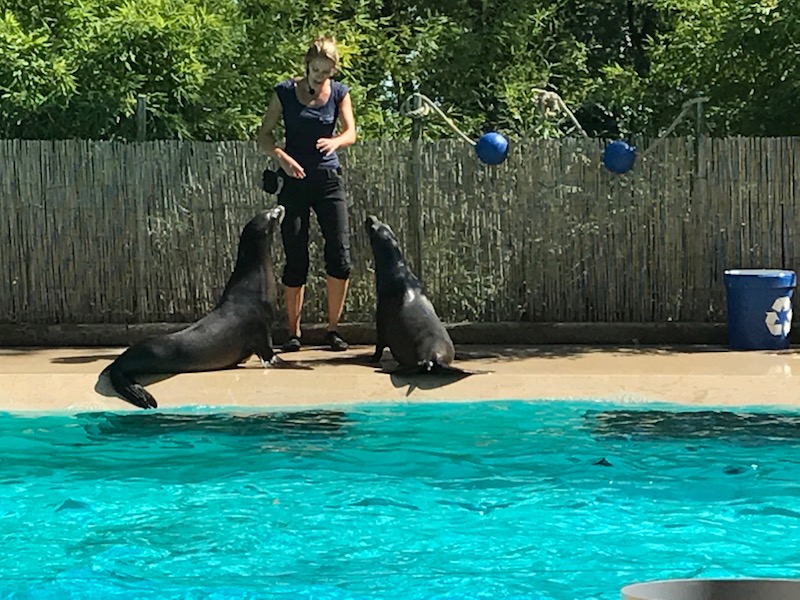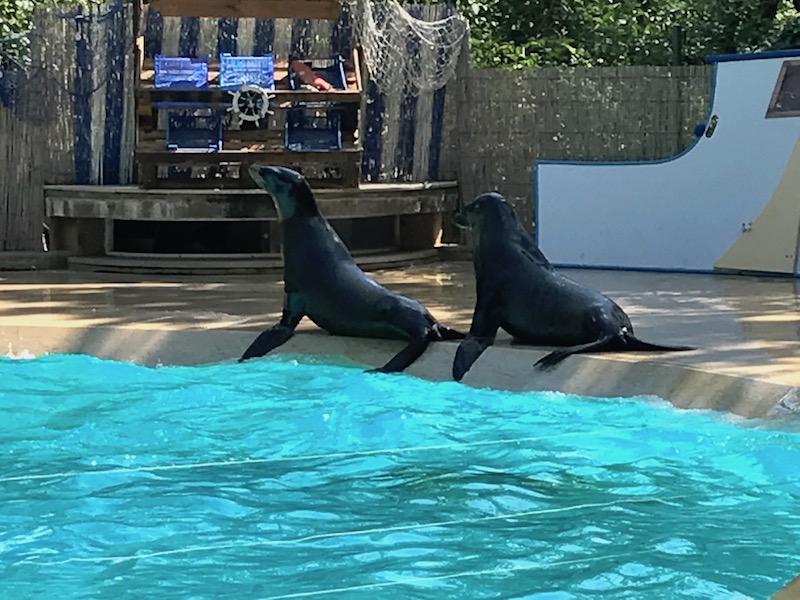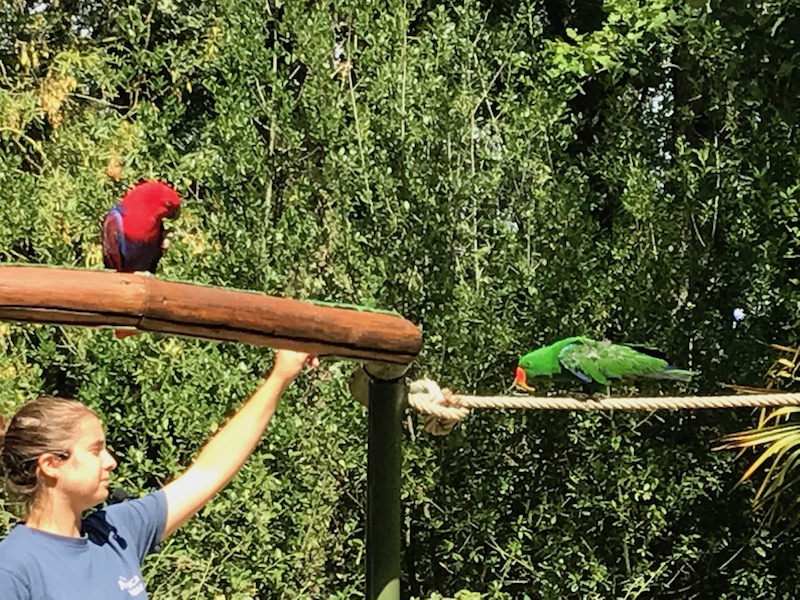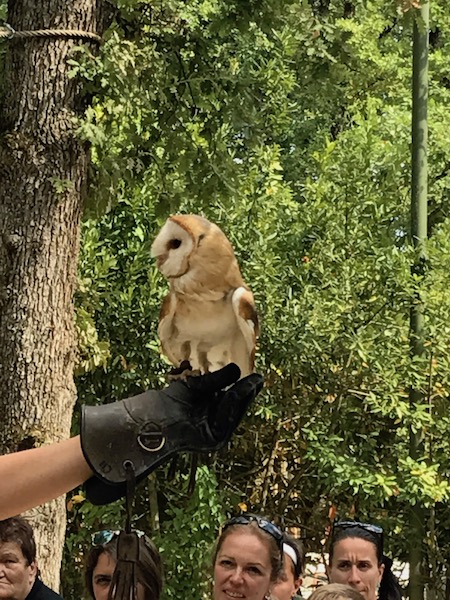Our Blog - Toulouse African Safari Zoo
Just a short drive outside of Toulouse, to Plaisance-du-Touch, is an African Safari Zoological park. We decided to pop over there on Saturday. It starts with a drive through an open area with various animals, including giraffes, elephants, antelopes, etc ... the "safari" part. Then you park and go into another section, which is more of the "zoo" part. It was created in 1970 with about 5 hectares of space and had about 50 domestic and wild animals. The African Reserve "safari" section open in 1990 and added 15 additional hectares. Some of the animals co-habitate in semi-freedom. An additional 5 hectares was added in 2014 to accommodate "the giants" of Africa: elephants, giraffes, and hippo's.
I'm not planning to put too much commentary in this blog .. I'll put headings in with what the animal is and if there is something interesting, I'll add it. However, I don't plan to tell you much about the actual animal :-)
Camels





Red lechwe, which is a type of antelope from the wetlands of Zimbabwe, Botswana, Namibia, and Zambia.










Scimitar oryx, once widespread across North Africa which went extinct in the wild in 2000.


Watusi cattle from Central-East Africa





Zebras





Blue Wildbeest is native to Angola, Botswana, Kenya, Mozambique, South Africa, Swaziland, Tanzania, Zambia and Zimbabwe. Today it is extinct in Malawi, but has been successfully reintroduced in Namibia.





White Rhino, these guys were separated, probably because they could actually hurt/kill the other animals


The roan antelope is a savanna antelope found in West, Central, East and Southern Africa. The name "roan" comes from the reddish brown color of their coats.


The ostrich is one of a couple of the same species in the zoo ... there were also rhea's and emu's in the zoo part.



Based on where these are, they could be Impala or Thomson Gazelle.



The baboons were separated out. These are Guinea Baboon's, which are classified as "near threatened" due to its small range and the loss of its habitat.


The Hippo's were also separated out, since they are aggressive animals. They are big ... adults average between 2800 and 3300 lbs, but fast ..capable of running up to 20 mph.





These are Angolan Giraffes and are found in northern Namibia, south-western Zambia, Botswana, and western Zimbabwe. Giraffes are the tallest living terrestrial animals.


African Elephant - one species of African elephant, the bush elephant, is the largest living terrestrial animal. You can see that there is one little baby in there!





The Eland Antelope is a savannah and plains antelope found in East and Southern Africa.




Needless to say, the Lions were sleeping! We could find a male and a female ... not sure if there were any others that were hiding.



We then headed into the "zoo" part of the park, which is listed as the "visit a pied" or "visit by foot". There were 30 different types of animals and they had 2 different shows (sea lions and birds).
Jaguars
Tom was fascinated by the big cats, especially the Jaguars. There were 3 in this first area: 2 black and one spotted. In jaguars, the gene that makes the cat black is dominant. Consequently, black jaguars may produce either black or spotted cubs, but a pair of spotted jaguars can only produce spotted cubs.













There were also a couple of Leopards next to the Jaguars.





The Siberian Tiger's were sleeping the first time around, but they were up and moving around as we headed back through the big cats on the way out. They are the epitome of "big cat", and can get up to 675 lbs. We're fascinated by just HOW BIG those paws are!













Another native of South America, the Llama are found both wild and domesticated.




The Yak is native to the Himalayas, and are among the largest bovids, second only to the gaur in shoulder height. You can see a little baby yak in there, which was born just a few weeks ago. The sign indicated that a baby yak can walk/follow its mother within minutes of birth.





There was a little pony there as well. We attempted some pictures of Susan with the pony, but they all came out looking like she was possessed, so we took them out.


The Rhea is another flightless bird, similar to the ostrich. While they are only normally found in South America, a small population of rheas has emerged in northeastern Germany, after several couples escaped from an exotic meat farm in the late 1990s. Contrary to expectations, the large birds have adapted well to the conditions in the German countryside.







A Mara is a large relative of a guinea pig and are from South America. Maras are the fourth-largest rodent in the world, after capybaras, beavers, and porcupines.



The red kangaroo is the largest of all kangaroos, the largest terrestrial mammal native to Australia, and the largest extant marsupial. It is found across mainland Australia, avoiding only the more fertile areas in the south, the east coast, and the northern rainforests.


South American Coati, which is a member of the raccoon family. They are very good climbers and they had put blocks on the top of the tree to keep them from climbing up too far.







Capuchin Monkey range from Central America to South America. The word capuchin derives from a group of friars named the Order of Friars Minor Capuchin, an offshoot from the Franciscans, who wear brown robes with large hoods. When explorers reached the Americas in the 15th century, they found small monkeys whose coloring resembled these friars, especially when in their robes with hoods down, and named them capuchins.




The Wallaby's were in an area that we could actually go into and walk around, so we were able to get fairly close to them.









This one I didn't get a good picture of, but it is a Blank and White Ruffed Lemur

Another Lemur, this one native to the island of Mayotte






You can totally understand why the Meerkat's had their own TV show :-) There was a group of meerkat's that we watched for a few minutes, and one of them came over to one side, stood on his back legs, and just somewhat watched the action next to us.






A really big turtle! I realize there are lots of various types, but there was nothing there to indicate the type.

Red Panda, native to Eastern Himalayas and SW China. As you can tell, they aren't very closely related to the big white and black balls of fur called the Giant Panda.




These were really cute, although difficult to get a picture of ... common marmoset.



Farm
So they had a little petting zoo that had lots of little goats. I think it was meant for kids, but we are just big kids at heart, right?









Birds



The Sahara oryx was once widespread across North Africa which went extinct in the wild in 2000.

The Tapir is generally from Central and South America, as well as Southeastern Asia.


Capybara is the largest living rodent in the world.

And what zoo would be complete without a small pond with pink flamingo's!




Otter Show
The otter show has 3 otters which came in 2015 from California: Nelly, Nora, and Cleo.









Bird Show
The the bird show, and there were a few different types of birds that basically flew over your heads (really low, in fact), from one perch to another for food.






